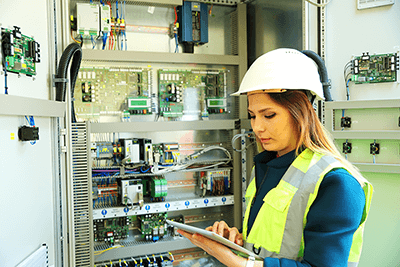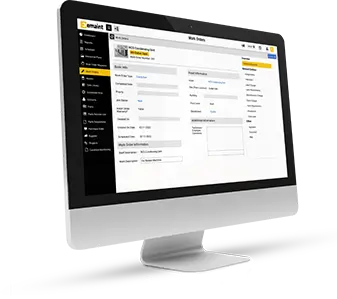 Three types of maintenance software dominate the asset management software market: computerized maintenance management system (CMMS) software, enterprise asset management (EAM) software, and asset performance management (APM) software. Each solution can give you critical, data-driven insights into your operations and help you get the most value from your equipment.
Three types of maintenance software dominate the asset management software market: computerized maintenance management system (CMMS) software, enterprise asset management (EAM) software, and asset performance management (APM) software. Each solution can give you critical, data-driven insights into your operations and help you get the most value from your equipment.
So, what’s the difference between CMMS vs. EAM vs. APM? And how can enterprises choose between them? The reality is that the lines have started to blur between each of these. For example, eMaint is both an award-winning CMMS and an award-winning EAM. And, when combined with our asset health software and Fluke sensors and tools, eMaint also has the solutions most look for in an APM.
It’s easy to get lost in the acronyms, so let’s break down what each system is, how they’re different, and how to leverage the right tech for your unique needs.
What is a CMMS System?

A CMMS is maintenance software for managing assets, work orders, inventory, preventive maintenance, condition monitoring, and more.
It further serves as a command center for maintenance and reliability programs and is a centralized database for storing your maintenance data. You can use its work order software to track work orders and gain insights into asset health and performance, as well as track spare parts inventory across multiple sites, even connecting parts with work orders.
Many modern CMMS also prioritize their mobile work order apps for maintenance management on the go. eMaint’s mobile CMMS even lets teams work offline. These work management features also prove vital when it comes to streamlining regulatory compliance.
Advantages of Using a CMMS
There are plenty of benefits to using a CMMS, but for the sake of brevity, we’ve narrowed it down to the top 5. (Read our complete list here: A Simple Guide to the Top 13 Benefits of CMMS Software.)
- Real-Time Work Order Updates: You can instantly update and streamline responses, therefore driving rapid and effective maintenance actions.
- Preventive Maintenance Planning: You can schedule maintenance tasks to prevent breakdowns and extend the lifespan of your equipment.
- Increased Worker Productivity: Boost efficiency by improving task management.
- Reduced Equipment Downtime: Concurrently, you can decrease operational interruptions to boost productivity and ensure continuous availability.
- Compliance and Safety Standards Adherence: Uphold rigorous safety and compliance standards, mitigating risks and enhancing reliability.
Here’s an example to illustrate the effectiveness of a CMMS: Pratt & Whitney, a well-known aircraft engine manufacturer, implemented eMaint CMMS to improve their maintenance operations. On a single project, they saved $100,000 and avoided three months of downtime by having the right parts available when needed.
With the CMMS, the team could manage inventory more effectively, keeping equipment running smoothly and reducing the time needed to obtain critical spare parts. The system also provided easy access to reports and dashboards, helping the team monitor part usage and anticipate when replacements would be necessary, which is key for maintaining optimal operations.
Intrigued by the results a CMMS can drive? To learn more about what a CMMS can do, see What is a Computerized Maintenance Management System?
What is an EAM System?
An enterprise asset management (EAM)system helps you manage all of your organization’s assets, your supply chain, spare parts inventory, financial systems, and more. In general, EAM refers not just to one software but to a strategy and ecosystem of multiple solutions working together to provide a holistic approach to asset lifecycle management — from procurement through to disposal.
The advantages of using EAM software
Here are the top five ways it can boost your organization’s asset management efforts:
- Streamlined Asset Management: Centralize your asset management on a unified platform, with better control and integration from procurement to performance insights.
- Maintenance Made More Efficient: Automate and prioritize maintenance tasks to reduce equipment failures and unnecessary downtimes, ensuring critical operations continue smoothly.
- Improved Asset Health and Performance: Monitor real-time data from condition monitoring tools to preemptively address potential issues, keeping your assets in optimal condition.
- Regulatory Compliance Assurance: And EAM, like a CMMS, can simplify compliance with regulations through automated tasks and electronic documentation, ensuring consistent adherence to industry standards.
- Superior Data-Driven Decision Making: Leverage detailed analytics to identify trends, make informed decisions, and optimize your asset management strategies effectively.
To learn more, see What is Enterprise Asset Management?
What is an APM Software?
An asset performance management (APM) software focuses on pairing modern maintenance software with technology like sensors to amplify asset management. An APM software system collects and analyzes condition monitoring data to help maintenance teams take data-driven actions that reduce asset failures and unplanned downtime — and ultimately extend an asset’s useful life.
The advantages of using APM Software
- Faster Recovery from Outages: APM tools significantly decrease Mean Time to Recovery (MTTR), reducing risks from new updates and changes, while minimizing recovery needs through proactive monitoring.
- Rapid Defect Diagnosis: Enhance application stability and user experience with APM’s streamlined defect identification, which frees up time for innovation and reduces user churn.
- Reduced Operational Costs: Optimize resource usage with APM’s detailed performance insights, leading to significant cost savings in application maintenance and operation.
- Unified Application Insights: APM offers a comprehensive view across your application stack, improving team collaboration and managing complex environments more effectively.
To learn more, see What is Asset Performance Management?
What is the difference between CMMS and EAM Software?
A computerized maintenance management system (CMMS) tracks preventive maintenance activities, inventory management, and repair catalogs. Meanwhile, an enterprise asset management system (EAM) is a holistic network of controlled systems, software, and services dedicated to the maintenance of physical assets and infrastructure throughout their entire lifecycle.
In other words, an EAM is core to your asset health and lifecycle strategy. It is a holistic system that impacts every aspect of your infrastructure and asset management.
Meanwhile, a CMMS is a tool that allows you to centralize and optimize the information integral to EAM. It enables you to automate tasks, streamline processes, and increase communication and transparency among your maintenance staff. A CMMS is also a control center for managing spare parts inventory, monitoring asset health, and executing your maintenance strategy.
However, an EAM offers additional functionality that takes the whole lifecycle of an asset into view – from acquisition to disposal.
This means that a CMMS can actually be a part of an overall EAM strategy. While a CMMS focuses on maintenance management, EAM addresses the bigger picture of asset management beyond maintenance.
What is the difference between EAM and APM Software?
An EAM connects physical assets across many locations at once to measure the cost of acquisition and decommission so you can extend the lifecycle of critical machines. EAM software provides business analytics for enterprises that are focused on reliability. When coordinating long-term projects, an EAM ensures resources are being properly allocated toward task completion. In addition, unlike APM, EAM typically refers to an overall strategy, not a singular software.
An asset performance management (APM) software is a platform explicitly used for two purposes: 1) helping organizations get the most out of their assets and achieve operational excellence, and 2) delivering real-time data and insights about the monitored assets.
Using an APM software can help you reduce unplanned downtime and extend the useful life of assets by enabling you to remotely monitor asset health and performance — and respond promptly where and when it matters most.
CMMS vs EAM: Which maintenance software is best for your business?
If you’re still confused having read through those similar sounding descriptions, it’s because CMMS, EAM, and APM providers are increasingly deploying software features that diminish the differences between each.
So, a CMMS like eMaint can connect to sensors like many APMs, and it also has powerful integrations to connect to other software through the enterprise like an EAM. Each organization needs to decide which features matter most to them.
Ultimately, which software you choose likely depends on which features your organization needs the most.
So, what does this mean for your business?
Let’s recap.
When Is a CMMS the Best Choice?
A CMMS is ideal for businesses transitioning from paper-based maintenance management or isolated digital systems, like spreadsheets, to a more transparent and efficient approach. It’s particularly beneficial for organizations looking to improve the organization and accessibility of maintenance information, streamline their maintenance operations, and increase the overall efficiency of their manufacturing and maintenance processes. For example, if your team creates thousands of work orders per year or often works in the field, you likely need a best-in-breed CMMS software for those purposes.
When Is an EAM the Best Choice?
An EAM system is best suited for organizations that require a comprehensive approach to managing the lifecycle of their physical assets from acquisition to disposal. It’s optimal for businesses that need to integrate asset management with other business systems to improve their decision-making and manage the entire spectrum of asset management activities, including maintenance, risk management, and strategic planning. Keep in mind that using a CMMS can be a part of your overall EAM strategy.
When Is an APM the Best Choice?
APM should be considered by organizations that prioritize operational excellence and need real-time insights into their asset performance to minimize downtime and extend asset life. It’s particularly useful for businesses that need to monitor the health and performance of assets across multiple locations, and who wish to implement predictive maintenance strategies based on accurate, real-time data. An example is Azima DLI whose high-resolution vibration systems and wireless sensors and automated vibration tools deliver diagnostic results about assets so that technicians can perform corrective actions immediately.
Key questions to ask yourself if you’re still confused about CMMS vs. EAM
If you’ve read through all this and still find yourself on the fence about which software to choose, let’s simplify it. Here’s how you might think about each option:
- Scope of Management: Think about the daily management of your assets. Do you primarily need to keep up with maintenance schedules and work orders, or are you looking for a comprehensive solution that covers the entire asset lifecycle, including procurement and disposal? A CMMS is perfect for focused maintenance management, while EAM offers a broader, more holistic view of asset management.
- Complexity of Your Needs: Assess the complexity of your asset management requirements. If your organization deals with a wide array of assets that require detailed monitoring, reporting, and regulatory compliance, EAM is likely more suited to your needs. If your focus is primarily on maintaining current assets with efficiency, then a CMMS might be sufficient.
- Custom Requirements: Every industry has its quirks. Does the software need specific features to comply with industry standards or to integrate with specialized equipment? You’ll need to check to see if the software can be tailored to meet these unique demands.
- Integration Smoothness: Another consideration is just how configurable the individual provider has made their software. The ideal software should integrate smoothly with your current ERP, financial software, and other critical operational systems, enhancing data flow and reducing manual entry errors. eMaint, for instance, works with teams to decide which features they need and then offers help throughout the implementation process.
Leveraging CMMS, EAM, and APM
Today’s CMMS, EAM, and APM solutions have become a structured powerhouse to manage both maintenance work and physical assets to get the most out of people and machines. All come with their own benefits, but remember – choosing the right softwre is about more than just features—it’s about finding a solution that integrates into your workflow and enhances your asset management practices effectively.
